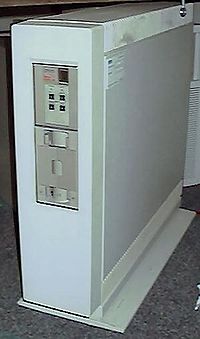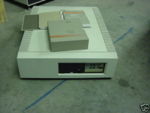Difference between revisions of "PDP-11/73"
m (→External links: +PDP-11 Systems Handbook) |
(Better layout; fix error in hampage excerpt) |
||
| Line 1: | Line 1: | ||
| − | [[Image: | + | [[Image:mpdp73.jpg|right|thumb|200px|PDP-11/73]] |
| + | The '''PDP-11/73''' is a high-end [[QBUS]] [[PDP-11]] system. Confusingly, the [[Central Processing Unit|CPU]] board is the [[KDJ11-B]] (M8190), the same as the [[PDP-11/83]] - no [[Digital Equipment Corporation|DEC]] '-11/xx' system seems to use the earlier [[KDJ11-A]] (M8192). (The ''Microcomputer Products Handbook'' does refer to the KDJ11-A as the "LSI-11/73 microcomputer", however.) | ||
| − | + | The difference between the /73 and /83 is that the latter uses [[Private Memory Interconnect|PMI]] [[main memory]], instead as the QBUS memory of the -11/73. | |
| − | |||
| − | The difference between the /73 and /83 is that the latter uses [[Private Memory Interconnect|PMI]] memory. | ||
== hampage.hu == | == hampage.hu == | ||
Quoting: | Quoting: | ||
| − | |||
<i> | <i> | ||
Introduced in 1984. Successor of the [[PDP-11/23]]. At that time the components were VLSI, and these PDP-11's were marketed as MicroPDP's (this has in fact begun with the PDP-11/23). The PDP-11/73 had a 15MHz [[J-11 chip set]]-based CPU with 22-bit memory management for the 4MB RAM max. Just to make life more complicated, 18 MHz PDP-11/83 CPU boards can also be found in PDP-11/73 systems, as a PDP-11/83 CPU (M8190-A[DE]) with QBUS memory (instead of the PMI memory used in those systems) is called a PDP-/73... | Introduced in 1984. Successor of the [[PDP-11/23]]. At that time the components were VLSI, and these PDP-11's were marketed as MicroPDP's (this has in fact begun with the PDP-11/23). The PDP-11/73 had a 15MHz [[J-11 chip set]]-based CPU with 22-bit memory management for the 4MB RAM max. Just to make life more complicated, 18 MHz PDP-11/83 CPU boards can also be found in PDP-11/73 systems, as a PDP-11/83 CPU (M8190-A[DE]) with QBUS memory (instead of the PMI memory used in those systems) is called a PDP-/73... | ||
| − | There was no UNIBUS equivalent. | + | There was no UNIBUS equivalent.</i>(Incorrect. The [[PDP-11/84]] shared the same CPU, and had a [[UNIBUS]].)<i> |
The J-11 was manufactured by Harris Semiconductors, and it hasn't been fully completed, it lacked the WCS and CIS options. | The J-11 was manufactured by Harris Semiconductors, and it hasn't been fully completed, it lacked the WCS and CIS options. | ||
| − | A very popular enclosure is displayed to the | + | A very popular enclosure is displayed to the right: this was the [[BA23 Enclosure|BA23]] standing tower configuration, that had place for a 8x4 backplane, an [[RX50]] floppy or [[TK50]] streaming tape drive and an RDxx hard disk. The BA23 could also be rack-mounted. |
</i> | </i> | ||
| + | [[Image:pdp11-73.jpg|150px|thumb|left|PDP-11/73 in a different style of box]] | ||
| + | <br clear=all> | ||
{{semi-stub}} | {{semi-stub}} | ||
Revision as of 14:41, 10 October 2024
The PDP-11/73 is a high-end QBUS PDP-11 system. Confusingly, the CPU board is the KDJ11-B (M8190), the same as the PDP-11/83 - no DEC '-11/xx' system seems to use the earlier KDJ11-A (M8192). (The Microcomputer Products Handbook does refer to the KDJ11-A as the "LSI-11/73 microcomputer", however.)
The difference between the /73 and /83 is that the latter uses PMI main memory, instead as the QBUS memory of the -11/73.
hampage.hu
Quoting: Introduced in 1984. Successor of the PDP-11/23. At that time the components were VLSI, and these PDP-11's were marketed as MicroPDP's (this has in fact begun with the PDP-11/23). The PDP-11/73 had a 15MHz J-11 chip set-based CPU with 22-bit memory management for the 4MB RAM max. Just to make life more complicated, 18 MHz PDP-11/83 CPU boards can also be found in PDP-11/73 systems, as a PDP-11/83 CPU (M8190-A[DE]) with QBUS memory (instead of the PMI memory used in those systems) is called a PDP-/73...
There was no UNIBUS equivalent.(Incorrect. The PDP-11/84 shared the same CPU, and had a UNIBUS.)
The J-11 was manufactured by Harris Semiconductors, and it hasn't been fully completed, it lacked the WCS and CIS options.
A very popular enclosure is displayed to the right: this was the BA23 standing tower configuration, that had place for a 8x4 backplane, an RX50 floppy or TK50 streaming tape drive and an RDxx hard disk. The BA23 could also be rack-mounted.
Further reading
- MicroPDP-11 Systems Owner's Manual (EK-MIC11-OM) - This, and the three related MicroPDP-11 manuals below, are not specific to the PDP-11/73, but contain a great deal of material which applies to the MicroPDP-11/73
External links
- MicroPDP-11 Systems Owner's Manual (AZ-FI13A-MC)
- MicroPDP-11 Systems Technical Manual (EK-MIC11-TM-002)
- MicroPDP-11 Systems Maintenance Guide (EK-MIC11-SG-001)
- PDP-11 Systems Handbook
| v • d • e PDP-11 Computers and Peripherals |
|---|
| UNIBUS PDP-11s - PDP-11/20 • PDP-11/15 • PDP-11/35 • PDP-11/40 • PDP-11/45 • PDP-11/50 • PDP-11/55 • PDP-11/70 PDP-11/05 • PDP-11/10 • PDP-11/04 • PDP-11/34 • PDP-11/60 • PDP-11/44 • PDP-11/24 • PDP-11/84 • PDP-11/94 QBUS PDP-11s - PDP-11/03 • PDP-11/23 • PDP-11/23+ • MicroPDP-11/73 • MicroPDP-11/53 • MicroPDP-11/83 • MicroPDP-11/93 QBUS CPUs: LSI-11 • LSI-11/2 • KDF11-A • KDF11-B • KDJ11-A • KDJ11-B • KDJ11-D • KDJ11-E Buses: UNIBUS • UNIBUS map • SPC • MUD • EUB • QBUS • CD interconnect • PMI Also: PDP-11 architecture • PDP-11 Extended Instruction Set • FP11 floating point • PDP-11 Memory Management |
| UNIBUS CPUs: KA11 • KC11 • KB11-A • KB11-B • KB11-C • KB11-D • KD11-A • KD11-B • KD11-D • KD11-E • KD11-EA • KD11-K • KD11-Z • KDF11-U
Co-processors: FP11-A • FP11-B • FP11-C • FP11-E • FP11-F • KE44-A • FPF11 Chips: LSI-11 • KEV11-A • KEV11-B • KEV11-C • F-11 • KEF11-A • KTF11-A • T-11 • J-11 • FPJ11 CPU options: KE11-E • KE11-F • KJ11-A • KT11-C • KT11-D • KK11-A • KK11-B • KT24 • KTJ11-B Rare CPU options: KS11 Memory Protection and Relocation option • KT11-B Paging Option • KUV11 Writeable Control Store Front panels: KY11-A • KY11-D • KY11-J • KY11-LA • KY11-LB • KY11-P More on buses: UNIBUS and QBUS termination • Bus Arbitration on the Unibus and QBUS • CTI BUS PDT-11s - PDT-11/110 • PDT-11/130 • PDT-11/150 CTI PDP-11s - PRO-325 • PRO-350 • PRO-380 Other: FIS floating point • PDP-11 Commercial Instruction Set • PDP-11 stacks • PDP-11 family differences |

